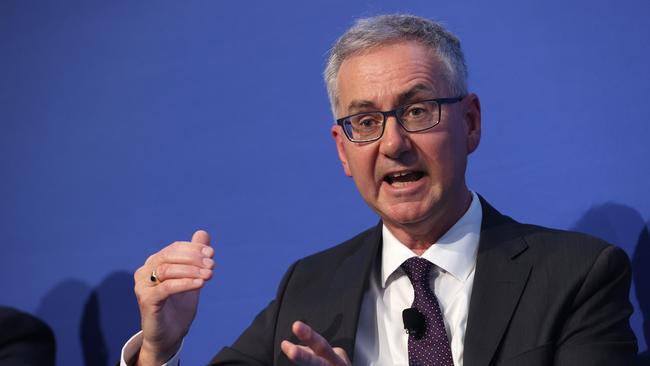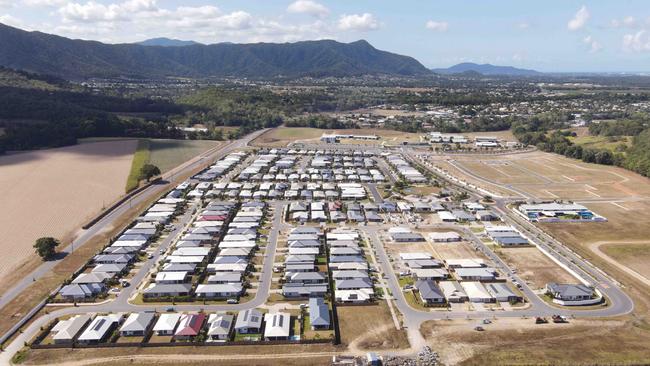APRA holds the line on lending laws, amid calls for relaxing borrowing limits
The prudential regulator says Australia’s household debts are huge, as it rejected calls to change the interest rate buffer used to determine home loan serviceability.

Australia’s banking sector was “particularly vulnerable” to any economic downturn with 35,000 households now behind on mortgage payments as the prudential regulator rejected calls to change the interest rate buffer used to determine home loan serviceability.
Ruling off its latest review of the country’s borrowing rules, the Australian Prudential Regulation Authority on Monday ordered the banking sector to make no changes to their lending practices, warning borrowers risked being squeezed further by debt and inflation as credit growth hit new highs.
APRA told regulated banks it would make no changes to lending buffers, a key measure by which the regulator controlled access to credit in the system, telling the sector to continue assessing borrowers at 3 percentage points above the product rate.
Speaking later on Monday, APRA chair John Lonsdale said more than $23bn in home loans were “non-performing” representing almost 1 per cent of all mortgages in Australia.
These troubled loans cover almost 35,000 households, with Mr Lonsdale noting although the level of stress was “relatively normal in historical terms” it was actually double levels recorded in 2016 and “trending up”. Mr Lonsdale warned Australia’s banking sector was “particularly vulnerable” to any downturn in the economy and growth in mortgage defaults.
“We would likely see banks withhold dividends to investors and curtail lending as their capital positions came under threat,” he said. “This would further weaken the domestic economy and amplify the impact of the crisis.”

This requires banks to determine if borrowers seeking to access a loan can meet repayments 3 per cent higher than current loan costs in the event the cash rate were to continue climbing.
Already several thousand borrowers who snapped up mortgages in the depths of the pandemic have passed their 3 percentage point buffers as the cash rate soared to 4.35 per cent from lows of just 0.1 per cent.
APRA set its 3 percentage point ceiling in October 2021, amid concerns Australians were driving house prices ever higher amid record low rates potentially baking in a debt bomb for the future.
Mr Lonsdale said inflation was continuing to moderate since the regulator reviewed its lending rules in July, noting the risk of higher interest rates “has receded somewhat”. But he warned APRA was concerned about “potential shocks to household incomes from a slowing labour market”.
Unemployment stayed steady at 4.1 per cent in October.
The APRA chair noted the risks to households were “exacerbated by uncertainty in the global economic environment, including geopolitical instability”.
Mr Lonsdale highlighted that new borrowing was continuing for households and businesses and was “accessible to good quality borrowers”.
He noted Australia’s breakneck house price growth, up 10.2 per cent over the year, had “eased” but warned homes were still 40 per cent more expensive than before the pandemic. “Household debt is high relative to incomes both compared with long-term trends and relative to international peers,” Mr Lonsdale said.
“This high household debt is a key vulnerability if adverse economic scenarios came to pass.”
APRA also told banks it would maintain its countercyclical capital buffer at 1 per cent of risk-weighted assets, with no limits on lending or constraints on capital distributions to different borrowing classes contemplated. The regulator said it was holding the rules steady, given a review of Australia’s banking system and home lending had highlighted a hefty debt burden and a pick-up in credit growth.
Data from the Bureau of Statistics found housing lending was up 18.9 per cent over the year to September, albeit with a 0.3 per cent fall in September.
This was driven by investor lending, up 29.5 per cent over the period. Borrowing for owner-occupiers was up 13.1 per cent.

Mr Lonsdale also pointed to an “uptick in non-performing loans”, highlighted by the big banks over their recent reporting season, noting the “potential for further rises, especially if unemployment increases”.
Deloitte Access Economics lead partner Pradeep Phillip said Australia’s economy faced a “fundamental challenge” from its housing market, which was driving costs higher in other areas amid surging prices.
Mr Phillip said the answer to high house prices wasn’t just cutting demand, but also improving supply “as quickly as you can”.
“APRA is taking a wait-and-see approach, they see a balance of keeping things the same for stability as being about right given the risks for existing mortgage holders and the financial system and economy,” he said.
But APRA’s move to hold its buffers steady attracted criticism from Liberal Senator Andrew Bragg, who is due to hand down an inquiry on Australia’s regulatory framework on Thursday.
APRA said about 5 per cent of new housing loans over the past year were given an exception from the three percentage points buffer, with Senator Bragg noting this showed the rules were “a very blunt object”. “The people that it’s blunting are first homebuyers – first homebuyers are disproportionately hurt by the blunt buffer,” Senator Bragg said.







To join the conversation, please log in. Don't have an account? Register
Join the conversation, you are commenting as Logout